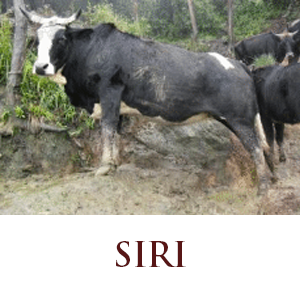Siri

The Siri is a small-sized indigenous Zebu draught breed, and found in the hill tracts around Darjeeling in Bengal, India and also in Sikkim and Bhutan. Siri is also known as “Trahbum”. This breed is said to be the native of Bhutan where it is known as “Nublang”. Its breeding tract includes Darjeeling, Gyalshing, Namchi, Gangtok, and Sikkim. The males are mainly reared in the hilly area, for draught purposes, and sometimes they are the only source of draught power for the region.
The Siri bullocks are good workers while the cows are fair milkers. These animals graze on the steep slopes of the hilly forests, and are mostly housed in open houses on the slopes. The Siri cattle can survive very well in the mountains, due to their long and powerful legs. The bulls are very valuable as they are one of the strongest amongst the native breeds and are well suited for the purpose of carting. They can carry about 350 to 400 kgs of weight, over the hills. They are also used for agricultural work such as ploughing, cultivating, threshing, etc.
Siri cattle are allowed to graze throughout the year despite the scanty pastures during most of the year. Dry animals and young stock are taken for pasturing in the government reserved forests at higher altitudes during summer months.
Characteristics:
- The Siri cattle are small to medium-sized animals, yet large in comparison with the other types of Zebu cattle breeds.
- This breed is either black or brown with white patches, though totally black or brown animals are also found.
- The white patches are characteristically on the face, legs, tail, under the body and the medial surface of the quarters. There are also white stripes from the withers to the dorsal vertebral column.
- They generally have a thick coat of long hair throughout the year.
- The head is generally small with square-cut, wide and flat forehead.
- The muzzle is usually black.
- The ears are of medium size and horizontal; and the eyes have black eyelids.
- The bulls and cows, both usually have horns. And their horns are long and sharp and usually covered with a tuft of long coarse hair.
- The horns are medium sized and curved outward, forward and slightly upward with sharp and pointed tips.
- The hump is placed slightly forward with a tuft of hair upon it. This is the only Indian cattle breed with the cervico-thoracic type of hump.
- They have strong legs and feet which are well suited for the ploughing fields.
- The hooves of the animals are broad but strong.
- The sheath in the male is tight.
- The dewlap is moderately developed.
- The udders of the cows are well-developed.
- The teats are centrally placed and cylindrical in shape with rounded tips.
- Height of the male varies between 138 and 141 cms., and that of the female varies between 121 and 124 cms.
- Body length of the male varies between 108 and 111 cms., and that of the female varies between 98 and 101 cms.
- Body weight of the male varies between 260 and 360 kgs., and that of the female varies between 212 and 307 kgs.
- Average chest girth of a male is 170 cms and that of the female is 152 cms.
- The cows are poor milkers and the milk yield ranges from 2 to 6 kg per day with an average yield of 425 kg per lactation.
- The average lactation length is about 7 to 9 months.
- Fat percentage in the milk varies from 2.8% to 5.5%.
- It has an inter-calving period of 420 to 490 days.
The milking cows and bullocks are stall-fed, and receive rice straw, maize stover or hay along with green grass. Concentrated feed is given in minimal quantities. The population of the Siri cattle has been found to be declining fast, on account of their crossbreeding with Jersey cattle.
In most of the states, either the crossbreds are fast replacing the indigenous cattle or the growth of the crossbreds are far ahead of that of indigenous cattle. This situation needs to be addressed urgently.
Our Surabhivana is committed to the movement of conserving our native Indian breed of cattle.
Indian Cow Facts
Siri is also known as “Trahbum”. This breed is said to be the native of Bhutan where it is known as “Nublang”. The Siri cattle can survive very well in the mountains, due to their long and powerful legs. The bulls are very valuable as they are one of the strongest amongst the native breeds and are well suited for the purpose of carting. They can carry about 350 to 400 kgs of weight, over the hills.In Siri Cattle, the hump is placed slightly forward with a tuft of hair upon it. This is the only Indian cattle breed with the cervico-thoracic type of hump.
